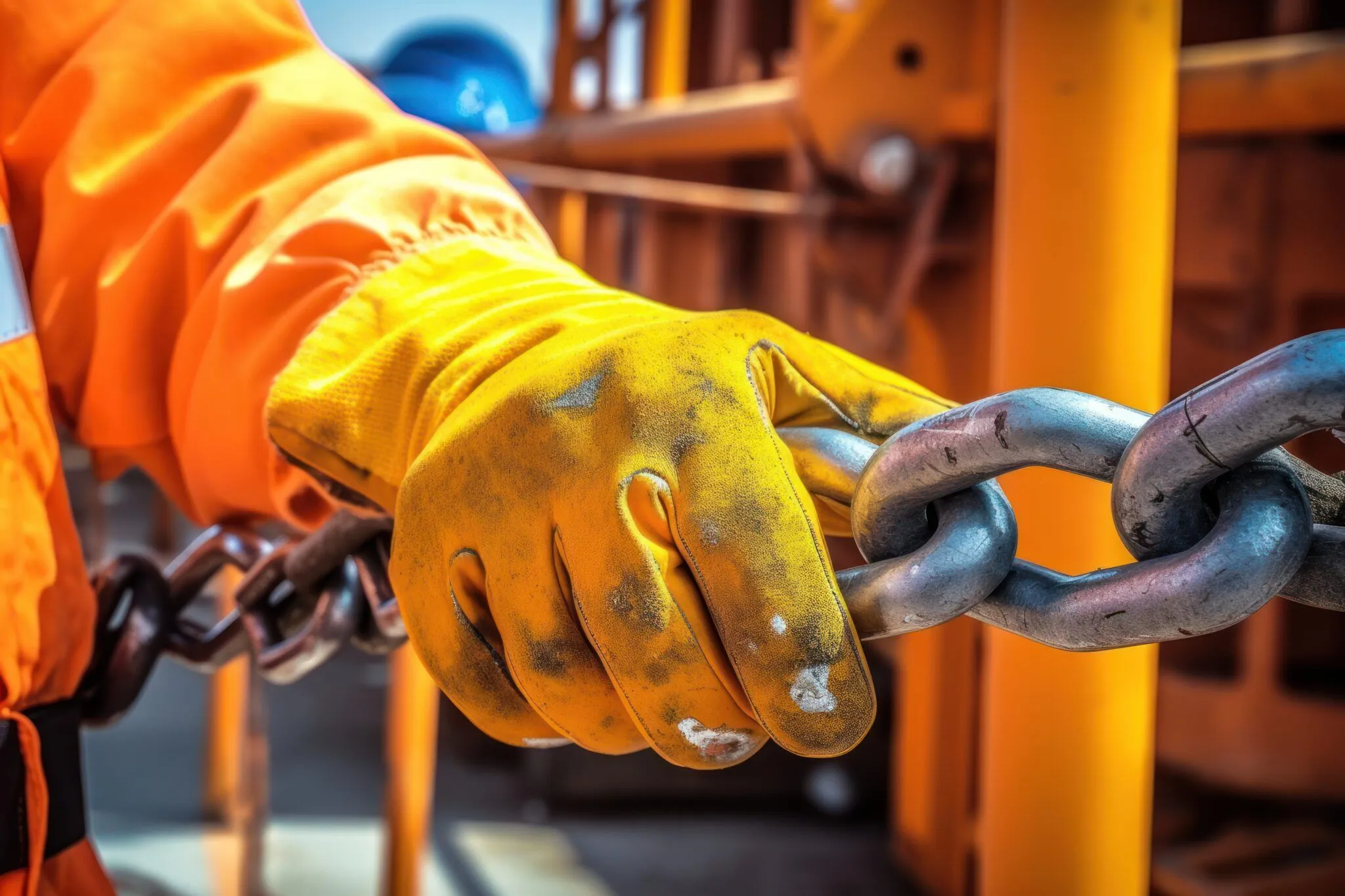Chain Grades – An Informative Guide
Chain Grades – An Informative Guide
In the world of rigging, the choice of chain can make all the difference. Whether you’re hoisting heavy loads in construction, securing cargo on a ship, or lifting equipment in an industrial setting, the type of chain you use can significantly impact safety and performance. This guide will delve into the various chain grades used in the rigging industry, their common applications, differences, potential problems, and common misuse scenarios.

Understanding Chain Grades
Chains used in rigging are typically categorized into several grades, each with its unique properties and intended uses. These chain grades are determined by factors such as material composition, tensile strength, and heat treatment. Let’s explore the most common chain grades:
Grade 30 Chain:
Grade 30 chain is the most basic and budget-friendly option. It is typically made from carbon steel and is not heat-treated, making it less durable compared to higher-grade chains. Its common uses include general-purpose lifting and towing applications, such as securing light loads on a trailer or as a barrier chain.
Grade 43 Chain:
Also known as High Test Chain, Grade 43 is a mid-level option. It boasts higher tensile strength due to its heat-treated construction, making it suitable for more demanding tasks like load binding, logging, and marine applications.
Grade 70 Chain:
Grade 70 chain, often referred to as Transport Chain, is a step up in terms of strength and durability. Made from heat-treated carbon steel, it offers a higher working load limit (WLL) compared to Grade 43. It is commonly used in the trucking and transportation industry for securing heavy cargo.
Grade 80 Chain:
Grade 80 chain is a high-strength alloy steel chain that is heat-treated for increased strength and resistance to wear and abrasion. It is frequently used in applications that require a high WLL, such as overhead lifting, rigging, and construction.
Grade 100 Chain:
The highest grade readily available, Grade 100 chain is known for its exceptional strength and durability. It is often used in critical lifting and rigging applications where safety is paramount, such as in the oil and gas industry.
Common Uses for Each Chain Grade
Each chain grade serves a specific purpose within the rigging industry:
Grade 30 Chain:
deal for light to medium-duty applications, such as securing loads on trucks, fencing, or as a visual barrier at construction sites.
Grade 43 Chain:
Used in load binding, logging, and marine applications due to its improved strength compared to Grade 30.
Grade 70 Chain:
Trusted in the trucking and transportation industry for safely securing heavy cargo.
Grade 80 Chain:
Commonly employed in overhead lifting, rigging, and construction due to its high strength and resistance to wear.
Grade 100 Chain:
Reserved for critical lifting applications where the utmost strength and safety are required, such as in the oil and gas sector.
Grade 120 Chain:
Grade 120 chain is an ultra-high-strength chain that is specifically designed for the most demanding and heavy-duty lifting and rigging applications. Its exceptional strength and durability make it suitable for specialized use cases where safety and reliability are paramount. Common usages for Grade 120 chain include:
- Heavy Machinery Lifting: Grade 120 chain is often used for lifting and rigging heavy machinery and equipment, such as large construction machinery, industrial transformers, and oversized components.
- Offshore and Marine Applications: In the offshore industry, Grade 120 chain is utilized for tasks like mooring large vessels, securing offshore platforms, and handling heavy loads in harsh marine environments.
- Oil and Gas Industry: This chain grade is critical in the oil and gas sector for lifting and positioning equipment on drilling rigs, as well as for handling subsea equipment during underwater operations.
- Mining Operations: In mining, where the loads can be massive, Grade 120 chain is employed for hoisting heavy materials, transporting ore, and securing equipment in rugged underground environments.
- Aerospace and Aviation: Grade 120 chain is used in the aerospace and aviation industries for tasks like aircraft engine handling, assembly line operations, and securing aircraft during maintenance.
- Infrastructure Construction: In large-scale infrastructure projects like bridge construction and building erection, Grade 120 chain plays a vital role in lifting and positioning structural components.
- Shipbuilding: Shipyards utilize Grade 120 chain for lifting and positioning large sections of ships and for securing ship components during construction.
- Heavy Load Transportation: Grade 120 chain is commonly used to secure and tie down heavy cargo on specialized transport vehicles, including flatbed trucks and trailers.
- Material Handling: Industries involved in handling oversized or exceptionally heavy materials, such as steel mills and foundries, rely on Grade 120 chain for safe and efficient material movement.
- Critical Lifting Applications: Any application where extreme strength and reliability are non-negotiable, such as in nuclear facilities or high-precision manufacturing, may require Grade 120 chain for critical lifting tasks.
Grade 120 chain may not be readily available everywhere, so it’s crucial to consult with industry experts and suppliers to ensure you have access to the appropriate chain grade for your specific needs. Grade 120 chain is available at Hercules SLR.
Differences Between Chain Grades
The key differences between these chain grades lie in their material composition, heat treatment, and ultimate strength. Higher-grade chains are engineered to withstand heavier loads and harsher conditions, making them the preferred choice for critical applications.
Common problems with chain grades often arise from a lack of understanding and misuse. Here are some of the most prevalent issues:
- Undersized Chains: Choosing a chain with a working load limit (WLL) that is too low for the task at hand can result in overloading and potential accidents. Always consult load charts and guidelines to select the appropriate chain grade for your application.
- Improper Storage: Chains are susceptible to rust and corrosion, especially if left exposed to the elements. Storing chains properly, such as in a dry and clean environment, can extend their lifespan and prevent weakening due to rust.
- Inadequate Inspection: Neglecting routine inspections can lead to missed signs of wear and damage. Chains should be regularly inspected for deformation, cracks, and elongation, and removed from service if any issues are detected.
- Mixing Chain Grades: Using different chain grades within the same rigging setup can lead to uneven stress distribution, potentially causing one chain to fail under heavy loads. It is essential to use chains of the same grade and size when creating assemblies.
- Lack of Lubrication: Chains that are not properly lubricated can experience increased friction and wear. Applying the right lubrication can help prolong the life of the chain and maintain its efficiency.
Common Misuse of Chain Grades
Misuse of chain grades can have severe consequences, including equipment damage and personal injury. Some common scenarios to avoid include:
- Using Grade 30 Chain for Critical Lifting: Grade 30 chains are not suitable for overhead lifting or other high-stress applications. Attempting to use them in such scenarios can result in catastrophic failure.
- Overloading Chains: Exceeding the working load limit (WLL) of a chain grade is a grave error that can lead to accidents. Always calculate the load and select the appropriate chain grade to ensure safety.
- Neglecting Chain Inspections: Failing to inspect chains regularly can allow hidden defects to worsen over time, increasing the risk of failure during operation.
- Ignoring Environmental Factors: Chains used in marine or corrosive environments should be appropriately coated or constructed from materials that resist corrosion. Neglecting this aspect can lead to premature chain failure.
- Improper Sling Angles: Incorrectly calculating sling angles when lifting loads with multiple chains can lead to unequal distribution of force, potentially causing one chain to fail under strain.
In conclusion, understanding the different chain grades in the rigging industry is crucial for ensuring safety and performance in various applications. Choosing the right chain grade, avoiding common problems, and preventing misuse are essential steps in maintaining a secure rigging operation. Whether you’re securing cargo or performing heavy lifting, selecting the appropriate chain grade can make all the difference in ensuring a safe and efficient operation.
——————————————————————————————————————————————
The Hercules Group of Companies encompasses a wide portfolio of products and services across 7 diverse companies.


